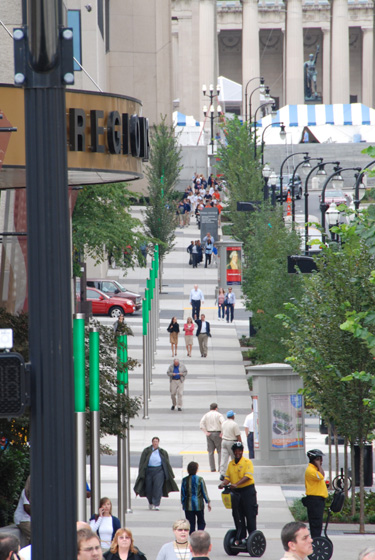Kim Hawkins, a principal with our office, recently spoke at this years StormCon in San Antonio, TX. She and Jim Snyder P.E., who at the time of the design and construction of the street was with Metro Nashville Public Works and who is now with Metro Nashville Water Services , spoke about the process of bring Nashville’s 1st Green Street to fruition. The following is the abstract about the presentation.
ABSTRACT: DEADERICK STREET – TENNESSEE’S 1ST GREEN STREET
Nashville, TN
Nashville Metro Public Works, Client
Hawkins Partners, Inc worked with the Office of the Mayor and Metro Public Works to transform a historically and civically significant corridor in the downtown area which serves as a physical connector between the city/county courthouse and the state legislative arm of government. Prior to the renovations, the street had become most widely known as the central transfer point for the Metro bus system. In the fall of 2008 the bus system’s hub was relocated one block north to the ambitious Music City Central, presenting an opportunity to re-envision the street itself.
Deaderick Street sits within the Kerrigan Basin, one of Nashville’s Combined Storm Sewer (CSS) basins, that has historically been subject to overflows., it is Nashville’s first implementation of LID features in the public right-of-way, the first green street in Tennessee and one of the first green street applications in the southeast. The renovations to the street primarily focused on addressing stormwater issues and urban trees. Pervious surface within the right of way was increased by 700% through the use of rain gardens, pervious concrete and .bioswales were implemented in pedestrian bulbs at the intersections. The site design worked within the context of the existing street and the existing storm drainage system, retrofitting existing storm drains to serve as overflow only. Rain gardens and bioswales were designed with engineered soils to allow infiltration and planted with plants, including many natives, that are adaptable to the extremes of wet and dry conditions. Based on Nashville’s historical rainfall patterns, infiltration rates and variable design factors, it is estimated that over 1.2 million gallons will be removed from the CSO system on an annual basis through this three block urban street..
In addition to the stormwater aspects of Deaderick, a number of other sustainable features were incorporated into the street, including LED lighting, recycled steel site furniture, crushed concrete as base aggregate material, fly ash for concrete and solar powered parking meters.














You must be logged in to post a comment.